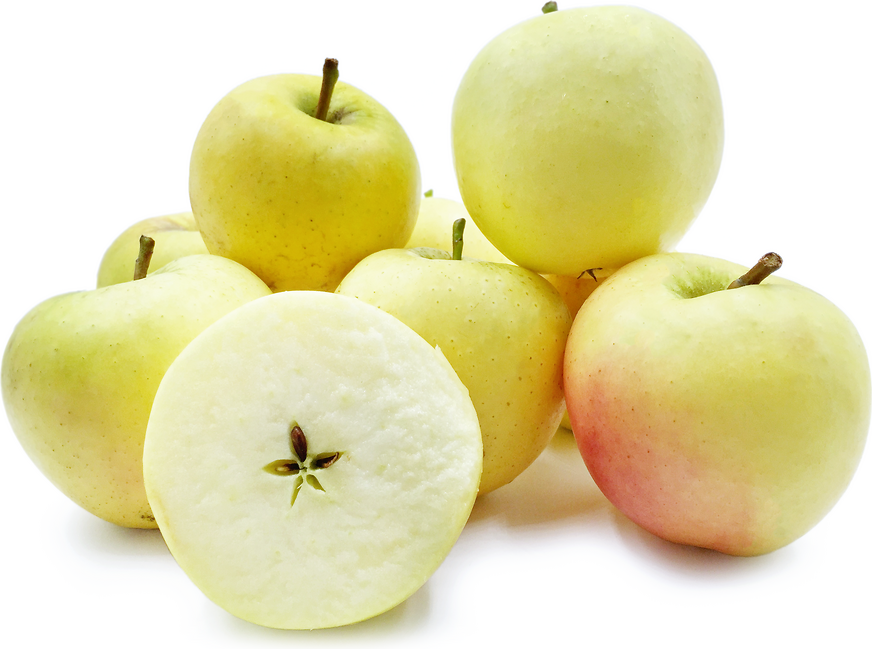


Paradis Sparkling® Apples
Estimated Inventory, lb : 0
Description/Taste
Paradis Sparkling® apples widely range in size from medium to large and are generally round to oval in shape, but the fruits can also take on a lopsided, sloped appearance. The skin is smooth, taut, and semi-thin, ripening from green to yellow with maturity, and is covered in pale lenticels and bright red blush with striping. Underneath the surface, the flesh is firm, crisp, pale yellow, and aqueous, encasing a small central cavity filled with black-brown, oval seeds. Paradis Sparkling® apples are aromatic and have a sweet, tangy, and sour flavor with a unique blend of acidity and sugar, creating a feeling of fizziness or sparkling when consumed.
Seasons/Availability
Paradis Sparkling® apples are available in the fall through winter.
Current Facts
Paradis Sparkling® apples, botanically classified as Malus domestica, are a relatively new variety released in 2015, belonging to the Rosaceae family. The fruits were developed by Swiss breeders Lubera and were selected for their unusual effervescent flesh. Paradis Sparkling® apples contain firm, crisp cell walls that release large amounts of sweet and acidic juice, giving the apple a sparkling or fizzy mouthfeel when consumed. Despite their whimsical nature, Paradis Sparkling® apples are not commercially cultivated due to the fruit’s irregular size, coloring, and shape. The fruits also have multiple harvest periods, making it difficult for growers to predict crop availability. Paradis Sparkling® apples are primarily a specialty cultivar grown in home gardens in Europe.
Nutritional Value
Paradis Sparkling® apples are a good source of fiber to regulate the digestive tract and contain vitamin C to strengthen the immune system and reduce inflammation. The apples also provide some potassium, calcium, and magnesium.
Applications
Paradis Sparkling® apples are best suited for raw applications as their effervescent nature is showcased when consumed fresh, out-of-hand. The apples can be sliced and served as a snack, or the fruits can be quartered and served on fruit platters and cheese plates. Paradis Sparkling® apples can also be cut and tossed into green salads, used as a fresh topping over yogurt, cereal, and granola, or coated in chocolate or caramel as a fresh dessert. It is important to note that the fruits will not retain their fizzy consistency when pressed into juices or utilized in cooked preparations. Paradis Sparkling® apples pair well with cheeses such as cheddar, manchego, and goat, other fruits including grapes, apricots, mangoes, citrus, and cranberries, and nuts such as almonds, walnuts, hazelnuts, and pecans. Whole, unwashed Paradis Sparkling® apples will keep 2 to 6 weeks when stored lightly wrapped in plastic in the crisper drawer of the refrigerator.
Ethnic/Cultural Info
New apple varieties are generally named right before they are released into commercial markets, but Paradis Sparkling® apples were named years before they were officially introduced. Breeder and founder of Lubera, Markus Kobelt, first sampled the variety growing in a Lubera orchard in 2006 and began extensively cultivating and studying the fruit for possible production. One year after its discovery, Kobelt gave the apple, formerly known as apple no. 85, to Tomi Hungerbuhler, a man Kobelt affectionately calls the “apple whisperer.” When Hungerbuhler tasted the variety, he described the fruit as having a “sparkling” consistency. Kobelt felt the sparkling descriptor accurately described the feeling of the fresh when eaten and decided to name the variety Sparkling®. Paradis Sparkling® apples were not released until 2015, and after eight years of planning and marketing, Kobelt still kept the same name to honor the unique story of the fruit.
Geography/History
Paradis Sparkling® apples were initially discovered at a Lubera research orchard in North Germany. Lubera is a Swiss company that breeds and produces plant varieties specifically marketed for home gardens, and founder Markus Kobelt has developed more than new eighty varieties for cultivation in his career. In 2006, Kobelt discovered Paradis Sparkling® apples growing on a small tree in a research orchard when he was sampling apple varieties with his cousin. The variety’s fizzy nature surprised Kobelt, and the apple was immediately sent to Lubera orchards in Switzerland for extensive research, testing, and cultivation. The variety was further developed at the Swiss orchards from a cross between resi apples, an East German variety, and English pirouette apples and was released to markets in 2015. Today Paradis Sparkling® apples are not commercially grown, but the variety is available for home gardening and small farm cultivation throughout Europe. The variety was also sent to the United States in 2019 for further testing and approval to be released to growers within the country.
Recipe Ideas
Recipes that include Paradis Sparkling® Apples. One
| Half Baked Harvest |
|
Fall Harvest Apple and Kale Salad |
| Five Heart Home |
|
Carrot Apple Slaw |




